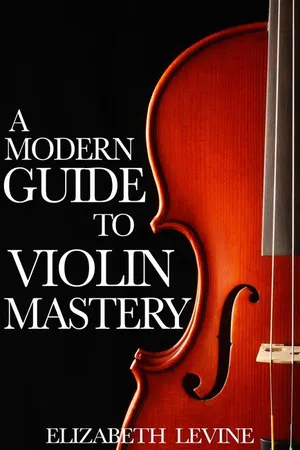
- 200 pages
- English
- ePUB (mobile friendly)
- Available on iOS & Android
About this book
This book is a straightforward, comprehensive guide to mastering the violin quickly and efficiently. This method of learning and practicing correctly is tailored specifically for children and adults in this busy modern age who want to be good at the violin but do not have time to fit in hours of daily practice. You will learn how to achieve the best results in the least amount of time and get the most from your instrument. Each section is carefully constructed and individually tailored to the needs of beginner, intermediate and advanced players. It comes complete with simple diagrams, and varied musical examples. You will learn how to attain a relaxed, professional posture in both hands and how to execute passages with ease and precision through a set of simple exercises. The book also comes complete with useful sight-reading strategies, which are addressed at the end of each section and can be applied at any level. Apart from perfecting your posture, overall technique and sight-reading, this book addresses simple, yet highly effective methods of practicing. These efficient and valuable practice techniques frequently used by professional players will help to achieve the best results in the least amount of time. If you are learning the violin and feel that your progress has halted and you have reached a stale point in your journey, this book is for you. This book holds the key pieces of wisdom that will augment your understanding of the violin and transform your playing.
Frequently asked questions
- Essential is ideal for learners and professionals who enjoy exploring a wide range of subjects. Access the Essential Library with 800,000+ trusted titles and best-sellers across business, personal growth, and the humanities. Includes unlimited reading time and Standard Read Aloud voice.
- Complete: Perfect for advanced learners and researchers needing full, unrestricted access. Unlock 1.4M+ books across hundreds of subjects, including academic and specialized titles. The Complete Plan also includes advanced features like Premium Read Aloud and Research Assistant.
Please note we cannot support devices running on iOS 13 and Android 7 or earlier. Learn more about using the app.
Information
• |
Beginner, Grades 1–3 |
• |
Intermediate, Grades 4–5 |
• |
Advanced, Grades 6–8 |
I. |
The Concept of Good Technique |
II. |
Bowing Technique |
III. |
Left Hand Technique |
IV. |
Practice Strategies |
V. |
Sight-reading |
• |
Learning technique |
• |
Practising technique. |
VI. |
What Makes a Good Performance? |
VII. |
Listening to Recordings of the Greats |
Table of contents
- Cover
- Title Page
- Copyright
- Dedication
- About the Author
- Contents
- Introduction
- Chapter 1 – How to Read This Book
- Chapter 2 – Beginner (Grades 1–3)
- Chapter 3 – Intermediate (Grades 4–5)
- Chapter 4 – Advanced (Grades 6–8)
- Conclusion
- Acknowledgement